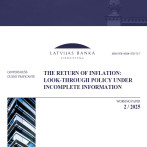In February inflation in Latvia was affected by public transportation in Riga
In February 2015, the annual inflation increased as expected, as the prices of public transportation services rose rapidly in Riga. Data indicate that a slight rise in oil prices also resumed in the global market, with the fuel merchants in Latvia having a fast reaction. According to the data of the Central Statistical Bureau (CSB), inflation reached 0.3% m-o-m and -0.1% y-o-y (without getting into the positive range, to a great extent, because of a further drop in heat energy prices).
The rise in oil prices found an immediate reflection in fuel prices: they rose 2.9% month-on-month and their year-on-year drop contracted to -17.3%. The impact of oil product prices on inflation was slightly increased by the value of US dollar, and in March its impact could increase further.
As expected, the heat energy prices in February dropped under the impact of natural gas tariffs, and not only prices but also the heat energy bill in February could look quite a bit more attractive than in February of other years, for because of the relatively warm winter, heat energy consumption went down. The impact of electricity prices on inflation remained unchanged in February, for most of consumers have chosen agreements with a fixed price for 12 or 24 months and apparently have not changed their tariff plan after paying the January bill. Even though in the first months of the year, the market price turned out to be more beneficial than was initially predicted for the year on average, within a year, it could balance out (the market price is usually highest in summer when power producers mostly do not operate in cogeneration regime and, at the same time, power output at hydroelectric power plants is at a low level and energy has to be imported.)
Unrelated to energy prices, the ticket prices of public transportation in February rose rapidly in Riga. As a result, the contribution of prices of transport services to the total annual inflation in February rose to 0.2pp.
In contrast to the seasonal trend, after a brief rise in the purchase prices of milk, at the beginning of the year they dropped (CSB data available for January), affecting also the consumer price level of dairy products (in January and February). In the global trends, however, it was just the opposite: in February, dairy products constituted one of the large groups that posted price rises connected with the period of drought in the largest dairy exporter countries and the milk production quota limits in the EU (FAO data). The prices of the rest of the agricultural and food products mostly dropped, moreover, the grain harvest projections for the marketing season 2014/2015 has been increased, indicating that a price rise in this group of goods is not expected.
Even though the demand and the related annual rise in unregulated prices of services in Latvia is one of the inflation maintaining factors, an increase in its impact is probably not likely. In 2015 a rise in wages related to institutional factors is once again observed and in some sectors the growth potential has grown somewhat (for instance, the resumption of AS KVV Liepājas Metalurgs operations is taking place albeit somewhat slowly). Yet overall, the increase in real income could slow this year and the positive part of inflation could rely on the supply side more than last year.
Textual error
«… …»






